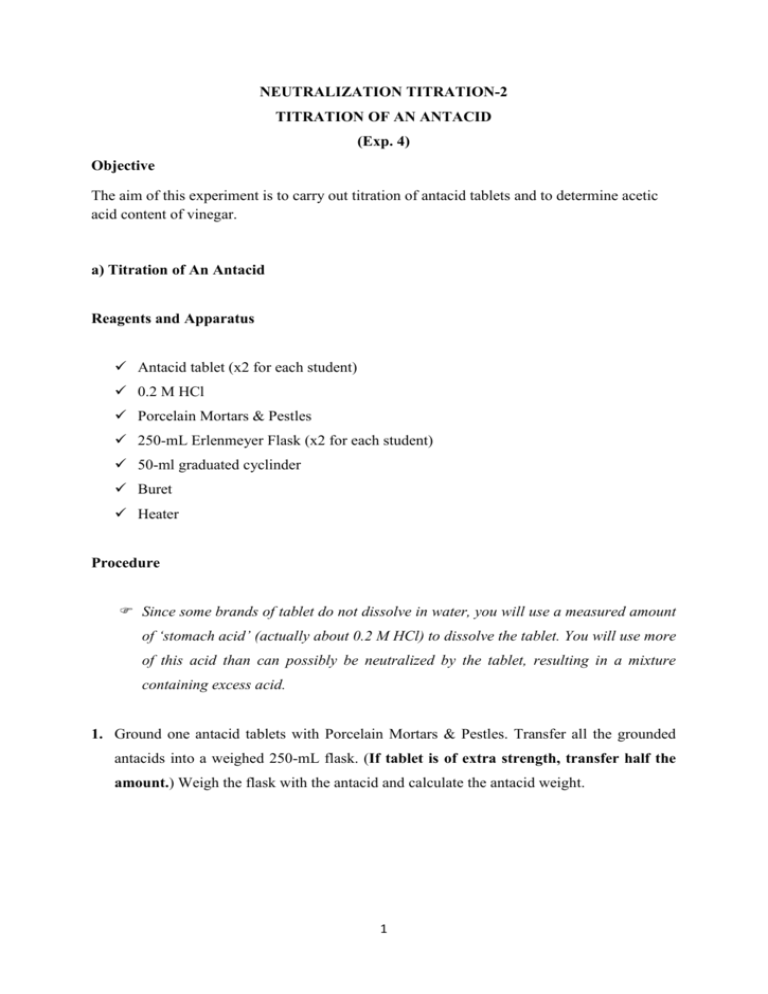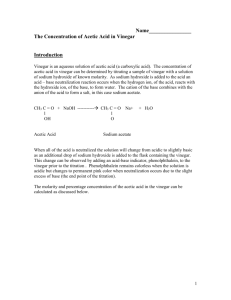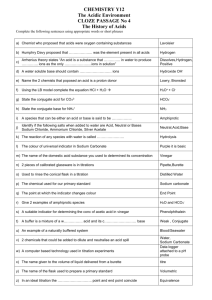NEUTRALIZATION TITRATION-2 TITRATION OF AN ANTACID (Exp
advertisement

NEUTRALIZATION TITRATION-2 TITRATION OF AN ANTACID (Exp. 4) Objective The aim of this experiment is to carry out titration of antacid tablets and to determine acetic acid content of vinegar. a) Titration of An Antacid Reagents and Apparatus Antacid tablet (x2 for each student) 0.2 M HCl Porcelain Mortars & Pestles 250-mL Erlenmeyer Flask (x2 for each student) 50-ml graduated cyclinder Buret Heater Procedure Since some brands of tablet do not dissolve in water, you will use a measured amount of ‘stomach acid’ (actually about 0.2 M HCl) to dissolve the tablet. You will use more of this acid than can possibly be neutralized by the tablet, resulting in a mixture containing excess acid. 1. Ground one antacid tablets with Porcelain Mortars & Pestles. Transfer all the grounded antacids into a weighed 250-mL flask. (If tablet is of extra strength, transfer half the amount.) Weigh the flask with the antacid and calculate the antacid weight. 1 Fig. 1 (a) Measurement of weight of antacid tablet and (b) grounding of tablet with Porcelain Mortars & Pestles 2. Fill one 50 mL buret of them with 0.2 M HCl 3. After recording the initial volume, allow approx. 45 mL of HCl to run into your 250 mL Erlenmeyer flask containing the grounded antacid. Do not allow the liquid level to drop below the 50 mL mark. Leave the solution in the buret! 4. Set the flask on heater, and heat until the solution boils. Continue boiling the solution for 5 minutes to remove any CO2 gas that may be liberated from carbonates in the antacid. Cool the flask. Fig. 2 Removal of CO2 gase via heating. 2 Neutralizing The Excess Acid Reagents and Apparatus Solution from previous part (x2 for each student) 0.2 M NaOH Methyl red Buret (x2 for each student) Dropper Procedure You will add base to the above mixture and measure the amount of base required to finish neutralizing the excess acid. The more base required in this step, the less effective was the antacid tablet at stomach acid neutralization. 1. Fill a second buret with 0.2 M NaOH. Record the initial volume. 2. Add 5 drops methyl red indicator to the solution in the flask, and titrate it with the NaOH solution. Methyl red is yellow if it is dissolved in a basic solution, and red in an acidic one. As the excess stomach acid is neutralized by the NaOH, the solution changes from red to yellow; the exact neutralization point is orange. If you add too much NaOH solution, you can add slightly more HCl from the first buret, and continue with NaOH addition until the endpoint is reached. Fig. 3 Color change of the solution after titration with 0.2 M NaOH 3 3. Read the final volumes on both burets. Repeat steps 1~7 one more time. b) Determination of The Acetic Acid Content Of Vinegar Background Vinegar is essentially a solution of acetic acid (HC2H3O2) in water. The concentration of acetic acid in vinegar may be expressed as a molarity (in mol/L) or as a mass percent, where: In this experiment, a technique known as a titration will be used to determine the concentration of acetic acid in vinegar. A titration involves performing a controlled reaction between a solution of known concentration (the titrant) and a solution of unknown concentration (the analyte). Here, the titrant is an aqueous solution of ~ 0.1 M sodium hydroxide (NaOH) and the analyte is vinegar. When mixed, a neutralization reaction occurs between sodium hydroxide and the acetic acid in vinegar: NaOH (aq) + HC2H3O2 (aq) NaC2H3O2 (aq) + H2O (l) The sodium hydroxide will be gradually added to the vinegar in small amounts from a burette. A burette is a device that allows the precise delivery of a specific volume of a solution. The NaOH will be added to the vinegar sample until all the acetic acid in the vinegar has been exactly consumed (reacted away). At this point the reaction is completed, and no more NaOH is required. This is called the equivalence point of the titration. In order to know when the equivalence point is reached, an indicator solution called phenolphthalein is added to the vinegar at the beginning of the titration. Phenolphthalein is a pH sensitive organic dye. Phenolphthalein is colorless in acidic solutions like vinegar, and deep pink in basic solutions like sodium hydroxide. At the equivalence point of the titration, just one drop of NaOH will cause the entire solution in the Erlenmeyer flask to change from colorless to a very pale pink. As the titration is performed, the following data will be collected: 4 The molarity of NaOH (aq) used The volume of NaOH (aq) used to neutralize the vinegar The volume of vinegar used Using this data, the molarity and mass percent of acetic acid in vinegar can be determined by performing a series of solution stoichiometry calculations. Reagents and Apparatus 5 ml vinegar (x3 for each sample) 0.1 M NaOH Phenolphthalein Distilled water 5 -mL volumetric pipette 25-ml graduated cyclinder 250-mL Erlenmeyer flask Buret Dropper Procedure 1. Take 5.00 ml of vinegar using a volumetric pipette and transfer into a lean 250-ml Erlenmeyer flask. Record this volume of vinegar (precise to two decimal places) on your report. 2. Add about 20-mL of distilled water and 5 drops of phenolphthalein to this Erlenmeyer flask. 3. Begin the titration by slowly adding NaOH(aq) from the burette to the vinegar in the Erlenmeyer flask. Swirl Erlenmeyer flask as you add the base in order to efficiently mix the chemicals. Some pinkness may appear briefly in the flask as the base is added, but it will quickly disappear as the flask is swirled. 4. As the equivalence point is approached, the pink color will become more pervasive and will take longer to disappear. When this occurs, start to add the NaOH(aq) drop by drop. Eventually the addition of just one drop of NaOH(aq) will turn the solution in the Erlenmeyer flask a pale pink color that does not disappear when swirled. This indicates that the equivalence point has been reached. Do not add any more NaOH(aq) at this point. 5 Measure this volume of NaOH(aq) precisely, and record it as the ‘Final Burette Reading’ on your report. Then show the resulting solution in the flask to your instructor so s/he can record the final color on your report form. 5. Refill your burette with NaOH(aq), and then repeat this procedure for a second sample of vinegar, and then a third sample of vinegar. You do not need to flush the tip of the burette again. Note that if you use less than 25 mL of NaOH(aq) for the second titration, you do not need to refill the burette for the third titration; also that you will need to clean out and re-use one of your Erlenmeyer flasks for the third titration. You and your partner should take turns performing these titrations. 6. When finished, dispose of your chemical waste as instructed. Calculation 1. Molarity of acetic acid in vinegar: i. First, using the known molarity of the NaOH (aq) and the volume of NaOH (aq) required to reach the equivalence point, calculate the moles of NaOH used in the titration. ii. From this mole value (of NaOH), obtain the moles of HC2H3O2 in the vinegar sample, using the mole-to-mole ratio in the balanced equation. iii. Finally, calculate the molarity of acetic acid in vinegar from the moles of HC2H3O2 and the volume of the vinegar sample used. 2. Mass percent of acetic acid in vinegar: i. First, convert the moles of HC2H3O2 in the vinegar sample (previously calculated) to a mass of HC2H3O2, via its molar mass. ii. Then determine the total mass of the vinegar sample from the vinegar volume and the vinegar density. Assume that the vinegar density is 1.000 g/mL (= to the density of water). iii. Finally, calculate the mass percent of acetic acid in vinegar from the mass of HC2H3O2 and the mass of vinegar. 6








